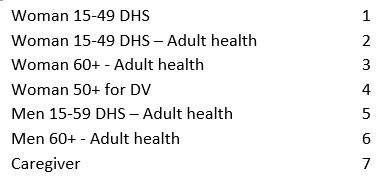| Re: HIV Prevalence among Couples in South Africa [message #18256 is a reply to message #18092] |
Mon, 21 October 2019 13:21  |
 Bridgette-DHS
Bridgette-DHS
Messages: 3230
Registered: February 2013
|
Senior Member |
|
|
Following is a response from DHS Chief of Data Processing, Guillermo Rojas:
We apologize for the delay with this response. To match the numbers in the report you need to download additional data files for this survey. Let us know if you cannot find them on the DHS website.
The design of the questionnaire in SA is very particular. Tables on HIV are based on individuals 15+ (not only 15-49) because they were also selected for the Adult Health questionnaire. However, we can't include in the standard DHS files women 50+ or men 60+, because they don't have relevant variables for DHS. Here are some notes on the recode documentation regarding these issues.
Notes on the Recode
1. The hierarchical recode file for this survey includes women 50+ and men 60+. Women 50+ and men 60+ are combined with a proportion of women ages 15-49 and men ages 15-59 for the adult health modules. Only women ages 15-49 and men ages 15-59 are used for DHS. As a result, when using this hierarchical file country specific variables SQTYPE and SMQTYPE should be used to select the appropriate unit of analysis. The flat files distributed by DHS already took into consideration these constrains and therefore they only include the correct individuals. Variables SQTYPE and SMQTYPE have the following codes:

For analysis of DHS for women, codes 1 and 2 from variable SQTYPE should be used to restrict the analysis to the correct women selected for the DHS survey. For Adult Health analysis for women, codes 2 and 3 from variable SQTYPE should be used. For DHS analysis for men, code 5 from variable SMQTYPE should be used. For adult health for men codes 5 and 6 from variable SMQTYPE should be used. The recode doesn't include the caregiver questionnaire because there is no recode definition for that type of questionnaire.
2. Male questionnaires as well as adult health questionnaires were applied in households selected for male survey and biomarkers (variable HV027 = 1)
3. Biomarker data for children, women and men were collected in households selected for male survey and biomarker. Biomarkers for women and men were collected for individuals 15 years old and above. Consent was requested form the respondent and where applicable from the parent/caretaker for anthropometry, blood pressure, anemia, HBA1C and HIV.
4. Selection for domestic violence included all women 18+ even in households where the adult health questionnaire was not applied. Women 49+ selected for domestic violence in households not selected for "Adult health", were asked question related to the adult health study, but that information wasn't used in the report. Questions on violence from partner were asked not only to ever married women, but to never married women that currently have or had a boyfriend (Question Q1502A in questionnaire). Tables in the final report were produced for all women selected for the module regardless of age.
Caution should be observed when analyzing adult health variables or domestic violence because the variables may be present in the file (i.e., in the woman's file) but they don't include all individuals that were selected for those studies. In general, if the intended analysis includes any of these variables it is advised to use the adult data files or the special file produced for domestic violence.
-
 Attachment: Capture.JPG
Attachment: Capture.JPG
(Size: 20.28KB, Downloaded 698 times)
|
|
|
|